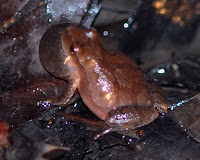Native plants.
We need 'em, or at least the butterflies do.
The best way to plant a "butterfly garden" is to focus on the native plants that butterflies lay their eggs upon. Butterflies tend to be host plant specific. For instance: no milkweed = no monarchs.
Wetlands in Ohio are in decline. We have lost over 90 percent of the wetlands our state once had. When you lose the wetlands, you lose the wetland's plants and the suite of butterflies that use them.
Jim Davidson likes butterflies. He likes them so much he bought a swamp just to see them.
He's got some real rarities here, like Dion and Duke Skippers. Their habitat is in pretty good shape, but he worries about the Baltimore Checkerspots. The deer eat their host plant Turtlehead. If the butterflies can't find enough plants to lay their eggs upon, he'll soon lose his Baltimore Checkerspot population.
So Jim is helping out Mother Nature, just a bit.
We visited Jim's swampy nature preserve, which he donated to the Columbus Metro-parks. He wanted to plant some more Turtlehead and protect it from deer browse. I speculated if the butterflies could get though that chicken wire. (They can.) He speculated I was a goof. (I am.)
Baltimore Checkerspot- the butterfly population we are hoping to increase.
About the size of a silver-dollar, that chicken wire won't slow them down a bit. Unfortunately, the deer were probably standing in the undergrowth licking their lips as Jim placed the new plant.
The last stage of the planting process is firmly supporting the wire cage with wooden stakes. This should slow the deer down and perhaps the checkerspots will get a decent meal this year. Jim and a parks employee monitor this site weekly to count butterflies along the transect. "Transect" is just a fancy word for a set trail or path one walks on a weekly butterfly count. By monitoring the same trail throughout the summer, we get a good idea of the ebb and flow of butterfly populations and the species seen in Ohio.
The data from these weekly walks is compiled and sent to the Ohio Lepidopterists. If you are interested in butterflies, join this fine group to learn more about the citizen science going on in Ohio and the many programs and field trips available to members.
We might even visit the Davidson Butterfly Preserve.

.JPG)
.JPG)
.JPG)

.JPG)



+Gulf+Fritillary.JPG)
+Gulf+Fritillary+_+Water+Pennywort.JPG)
+Gulf+Frit+Cat_CBH.JPG)
+Gulf+Frit+Cat_parasite.JPG)

+Peregrine+Falcon.JPG)


+Cheryl+Harner+and+Ryan+Steiner.JPG)

_+Path+to+Nelson's.JPG)
+Savannah.JPG)
+Kenn+and+Kim+Kaufman.jpg)

Brown+Pelican_CBH.JPG)
+Pelican+squadron.JPG)
+Waiting+for+fish.JPG)
+CBH.JPG)
+Shelly+on+overlook.JPG)
+Hanging+Gardens.JPG)
+Carex+plantaginea.JPG)
+Carex+plantaginea.JPG)





+Greg+Lipps+and+Tyrone+Hayes.JPG)
.JPG)

+Hellbender+Map.JPG)












